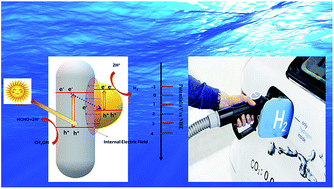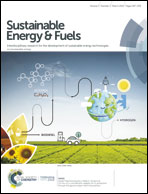In situ preparation of CdS decorated ZnWO4 nanorods as a photocatalyst for direct conversion of sunlight into fuel and RhB degradation†
Abstract
CdS nanoparticles have been grown on the surface of ZnWO4 nanorods via an in situ hydrothermal approach and their photocatalytic activities towards hydrogen (H2) evolution and dye degradation under solar light have been demonstrated. The structural, optical and morphological studies of CdS@ZnWO4 heterostructures with varying contents of CdS have been conducted. High resolution transmission electron microscopy (HRTEM) analysis showed sensitization of CdS nanoparticles (25 nm) on ZnWO4 nanorods of diameter 30 nm and length −200 nm. A decrease in the photoluminescence intensity of ZnWO4 was observed with increasing amounts of CdS nanoparticles which indicates inhibition of charge carrier recombination. Considering the band gap in the visible region, a photocatalytic study has been performed for hydrogen (H2) production from H2O and Rhodamine B (RhB) dye degradation under natural sunlight. The rate of photocatalytic H2 evolution for CdS@ZnWO4 is 105 times higher than that of pristine ZnWO4. Similarly, excellent photocatalytic activity was observed for CdS@ZnWO4 (20% CdS) composites against RhB degradation which is 4.7 times higher than that of pristine ZnWO4. With increase in the amount of CdS nanoparticle loading on ZnWO4 nanorods, the H2 generation rate was observed to be decreased after 15% CdS loading whereas, the dye degradation rate is increased. Such nano-heterostructures may have potential in other photocatalytic reactions.



 Please wait while we load your content...
Please wait while we load your content...